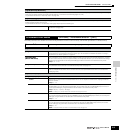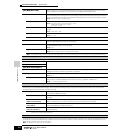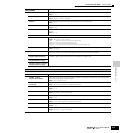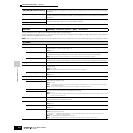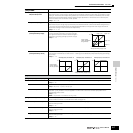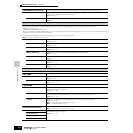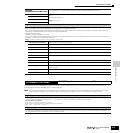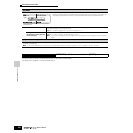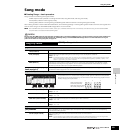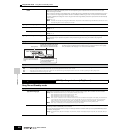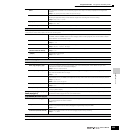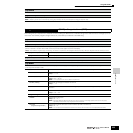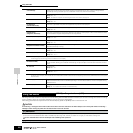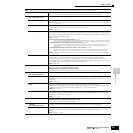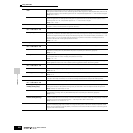
Reference Song Mode
Song Play mode
221
Owner’s Manual
Song mode
■ Creating Songs — basic procedure
Songs consist of the following three types of data:
• MIDI sequence data (created in the Song Record mode, Song Edit mode, and Song Job mode)
• Setup data (created in the Song Play mode)
• Mixing data (created in the Song Mixing mode/Mixing Edit mode and stored in the Song Mixing Store mode)
After creating the data in these modes described above, store the Mixing settings in the Song Mixing Store mode to archive it as Song data and
save the entire Song to the SmartMedia/USB storage device in the File mode.
n Non-note MIDI events (such as Voice number, volume, pan, and effect send level) which are necessary at the start of a Song are not recorded as MIDI
sequence data, but are stored instead as Mixing data.
Because Song data (MIDI sequence data, Setup data, and Mixing data) is recorded to DRAM (page 187), it will be lost when turning the power off. Make sure
to save any Song data created via the Record, Edit, Job, and Mixing setting to the SmartMedia/USB storage device in the File mode before turning the
power off. For details on saving Song data, see page 132.
Song Play mode
[SONG] → Song selection
[F1] PLAY
See page 55.
Loc1 (Location1),
Loc2 (Location 2)
Indicates the measure number to which the Song playback can be jumped by using the Location feature (page 58).
Trans (Transpose) Determines the key transpose setting for the entire Song, and can be adjusted in semitones.
Settings: -36 ~ +36
n If Transpose is applied to a Drum Voice, the results may not be musically appropriate. To ensure proper playback of a Drum
Voice, set the Note Shift parameter for the Drum Voice Part to an appropriate value ([SONG] → [MIXING] → [EDIT] → Part
selection → [F4] TONE → [SF1] TUNE → NoteShift).
MEAS (Measure) Indicates the current measure number and beat for the current Song. During playback, this indication changes
automatically according to the Song playback. You can input the desired measure number directly by using the
Number Input window called up via the [INFORMATION] button.
[SF1] ARP1 (Arpeggio 1) - [SF5]
ARP5 (Arpeggio 5)
You can register the desired Arpeggio types to these buttons and call them up any time during your keyboard
performance. Refer to page 105 in the Quick Guide section.
[F2] GROOVE (Grid Groove)
The Grid Groove function makes it possible to adjust the pitch, timing, length, and velocity of notes
in a specified track via a 1-measure 16th-note grid to create “grooves” that would not be possible
with precise sequencer-like programming. The Grid Groove function affects Song playback without
actually changing the sequence data.
NOTE OFST (Note Offset) Raises or lowers the pitch of the note(s) on the selected grid in semitones.
Settings: -99 ~ +99
CLOCK SFT (Clock Shift) Shifts the timing of the note(s) on the selected grid forward or back ward in clock increments.
Settings: -120 ~ +120
GATE OFST (Gate time Offset) Lengthens or shortens the note(s) on the selected grid in clock increments.
Settings: -120 ~ +120
VELO OFST (Velocity Offset) Increases or decreases the velocity of the note(s) on the selected grid.
Settings: -127 ~ +127
[F3] TRACK
[SF1] CHANNEL
From this display you can set the MIDI output channel/port for each of the sixteen tracks of the corresponding
internal/external tone generator.
OUT CH (Output Channel) Sets up the MIDI output channel for each track. Tracks set to “Off” will not sound.
Settings: off, 01 ~ 16
n In the Song/Pattern mode, the MIDI message created by playing the keyboard/knobs/wheels is sent to the tone generator
block or the external MIDI instruments via the MIDI output channel of the currently selected track.
CAUTION
+
VELO OFST (Velocity Offset)
GATE OFST (Gate Time Offset)
CLOCK SFT (Clock Shift)
NOTE OFST (Note Offset)
0
–



